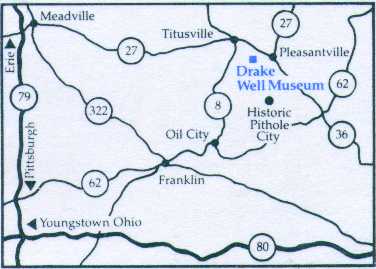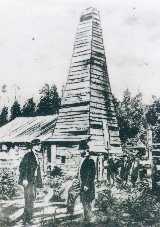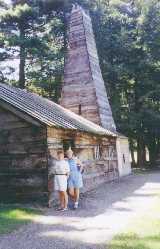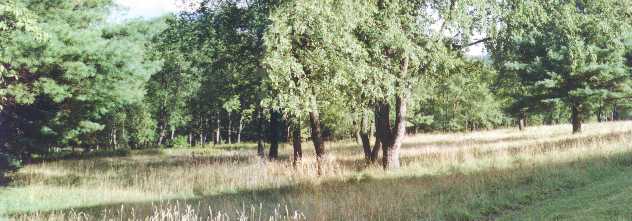
 Oil Creek was named for the oil springs occurring along its banks. There are many pits, still visible today, dug by Indians for the purposes of collecting petroleum which they used as medicine.
Oil Creek was named for the oil springs occurring along its banks. There are many pits, still visible today, dug by Indians for the purposes of collecting petroleum which they used as medicine.
The Oil Creek Valley is located about an hour's drive north of Pittsburgh. There are several historic sites in the valley that make it a worthy destination for a day trip. The World's first oil well was drilled here, and the first oil boom followed soon after.
For train afficianados, there is a mail train that runs from Titusville to Drake's Well. There is also a bike trail paralleling the creek and people can transport their bicycles one way on the train, and bike back.
|

 In 1858 "Colonel" Edwin Drake was hired by the Seneca Oil Company of New Haven, Connecticut, to see if he could improve the output of the oil spring the company had leased near Titusville. After an unsuccessful attempt at digging, he decided to drill a well. Drake went to the salt well drillers near Pittsburgh for help. William "Uncle Billy" Smith, of Tarentum, came to Tutusville in the spring of 1859 and began to erect the derrick and engine house that would be needed. Drilling began in June or July, but the glacial till that fills the Oil Creek Valley kept caving into the hole.
In 1858 "Colonel" Edwin Drake was hired by the Seneca Oil Company of New Haven, Connecticut, to see if he could improve the output of the oil spring the company had leased near Titusville. After an unsuccessful attempt at digging, he decided to drill a well. Drake went to the salt well drillers near Pittsburgh for help. William "Uncle Billy" Smith, of Tarentum, came to Tutusville in the spring of 1859 and began to erect the derrick and engine house that would be needed. Drilling began in June or July, but the glacial till that fills the Oil Creek Valley kept caving into the hole.
Drake finally had the idea of driving a pipe down to bedrock and drilling inside it. Once this was accomplished, drilling proceeded smoothly until on August 26th the drill bit dropped into a crevice. Work was stopped for the day, and when Uncle Billy checked the well the next day he found it full of oil. A pump was attached and the well began producing 20 barrels of oil a day, more than double the rate of production of the other sources at that time.
|
 Today, a museum and park surrounds the site of that first oil well. The derrick and engine house have been reconstructed and there is full size demonstration of the means used to connect several oil wells to a single pumping station. The rod lines alternately pulled and released the jacks that were mounted over the wells. It was a very efficient method.
Today, a museum and park surrounds the site of that first oil well. The derrick and engine house have been reconstructed and there is full size demonstration of the means used to connect several oil wells to a single pumping station. The rod lines alternately pulled and released the jacks that were mounted over the wells. It was a very efficient method.
In the museum, which displays the same system in model form, you can see a film starring Vincent Price as "Colonel" Drake, and a number of antique carts and wagons including an 1865 Nitroglycerine Wagon and a fire wagon dating from 1892.
Hours for Drakes Well Park: Tues-Sat 9am-5pm, Sun, noon - 5 pm. There is an admission charge. On August 26, there is a special celebration in honor of the birth of the oil industry at Drake's Well.
|

There is also a museum at the site of Pithole City, advertised as Western PA's only "ghost" town. This boast is not entirely true, the region is scattered with clusters of foundations marking the sites of former coal patch towns. But Pithole was the biggest, shortest lived, and by far the most notorious.
The museum sits on the road, with wide windows looking down to Pithole creek. On the meadow, between the museum and the creek, once stood Pithole City. In 1864 the region was a wilderness; this land was the farm of Thomas Holmden and before oil was discovered, there were only 3 cabins sitting on this vast meadow.
The Humbolt refinery was situated only 4 miles from the Holmden farm. Two employees of the refinery leased 65 acres from Thomas Holmden, proposing to drill for oil. This was truly a wildcat venture as at that time virtually all the oil produced in the world came from the Oil Creek Valley. These two men, I.N. Frazier and James Faulkner, selected the spot for drilling with the use of a witch hazel twig. They began drilling what was later named the "Frazier Well". On January 7, 1865, the Frazier Well began producing oil at 250 barrels a day. Several months later, a Boston company completed a well, known as the Homestead Well, just 100 ft. outside the boundary of the Holmden farm. It also produced at a rate of 250 barrels a day.
The stampede was on. Hundreds thronged to Pithole. The company formed by Frazier and Faulkner, the United States Company, divided the property into half acre leases which sold for $3,000. In May, 1865, the plot for the city of Pithole was laid out on the hill. A boom town virtually sprang up overnight. Buildings were often completed in a week, which made for extremely flimsy construction. There was not one brick or stone building erected in Pithole.
 To see Pithole City as it once looked, just drag your mouse across this present day picture.
To see Pithole City as it once looked, just drag your mouse across this present day picture.
By August of 1865, Pithole had a population of over 15,000 . Living conditions were often improvised. Drinking water was scarce; profiteers hauled water from distant wells and sold it at 10 cents a drink. The liquor business flourished. Pithole had no sewage system. The smells of human habitation plus the aroma of crude oil gave first time visitors an unpleasant impression.
In 1866, the wells began to dry, and there was a series of disasterous fires. By the end of 1867 Pithole was, for all purposes, dead. Within a few years all that remained were cellar holes and odds and ends of lumber and debris to mark the site where one of the great bubbles of oil history had burst.
|